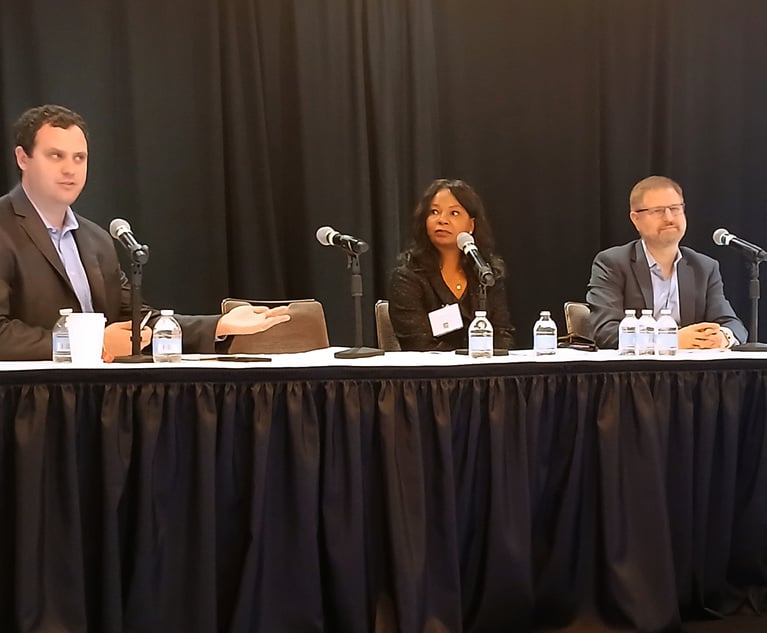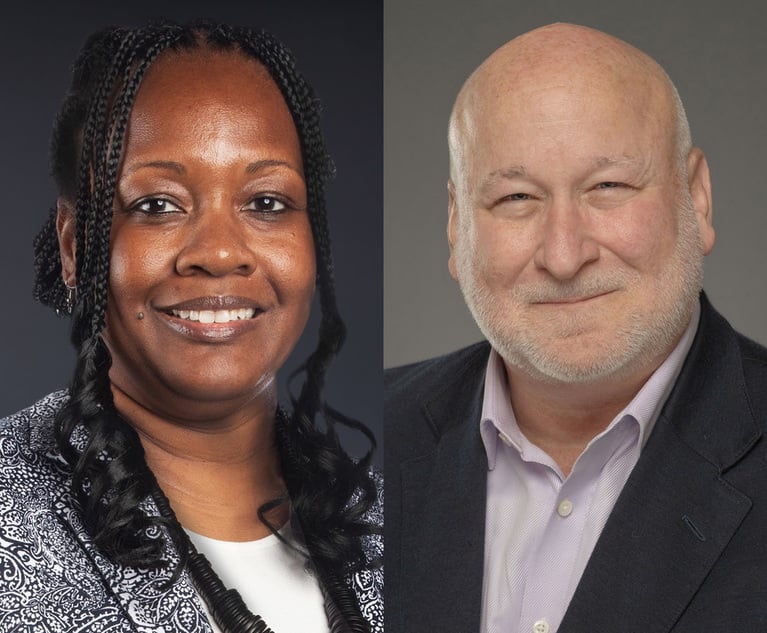Robust Patent System is Key to Prosperous U.S. Economy
In a competitive economy, the country's prosperity depends more than ever on a healthy patent system.
April 30, 2010 at 08:00 PM
4 minute read
Five years ago this summer, Congress embarked on efforts to reform the nation's patent system. Members of the House and Senate introduced legislation focused on bringing patents into the global economy of the 21st century. After half a decade of debate and the recent emergence and growth of a middle ground on the issue in Congress, there's cause for optimism that the time for real progress finally has arrived.
Patent reform reflects a historical fact of life: The nation needs to update the patent system periodically to address technological change. The need for legal evolution is especially pronounced when new technologies reshape the economic and cultural landscapes. We've witnessed this phenomenon intermittently since the 1800s, when rapid industrialization led to patent controversies that erupted on the front pages of the nation's newspapers.
The nation is grappling today with new stresses on the patent system. The explosion in information technology, with intricate devices that sometimes contain hundreds of newly patented features, has helped lead to a tripling of annual patent filings over the past two decades. A globalizing economy has reinforced this surge, with companies around the world filing patent applications in the United States.
All of this has put broadened demands not only on the U.S. Patent and Trademark Office (PTO) but the country's federal judges and juries as well. When it comes to making important decisions, the American patent system arguably demands more of untrained, nonspecialists than any other legal system in the world. In one of Microsoft's recent cases–a technically complicated patent lawsuit with hundreds of millions of dollars at stake–the group of eight jurors failed to include even a single college graduate. But it did include two individuals who did not complete high school.
It's important to reduce the stresses on the jury system, in particular. This is one reason patent reform legislation aims to give the PTO new tools to strengthen the quality of its decision-making at both the pre-grant and post-grant stages. David Kappos, who heads the office, has wisely recognized that the PTO can take some of the pressure off the jury system if it accelerates its re-examinations of patents, especially when key patents head toward litigation. If the PTO can move faster than the litigation process, then its re-examination results can be considered by judges before a lawsuit runs its course.
It's also vital that district judges fulfill their evidentiary gatekeeper role. The current pursuit of “lottery ticket justice” can tempt expert witnesses to offer theories that are more creative than grounded in substance. The Federal Rules of Evidence require that expert testimony must be “not only relevant, but reliable.” Few cases rely on this stricture more heavily than the calculation of damages in patent lawsuits. This is one reason that patent reform legislation has focused on damages issues in general and strengthening the gatekeeper role of judges in particular.
Ultimately, one of the lessons of history is that no single piece of legislation is likely to keep the patent system current. Progress comes through a combination of congressional action and judicial decisions.
This pattern is holding true in our time as well. The Supreme Court has increased its review of patent issues, using its authority to nudge patent law forward in careful increments. Even the passage of new legislation is unlikely to mean the end for this need, as important remaining substantive issues likely will require this type of judicial review.
In an increasingly competitive and global economy, the country's prosperity depends more than ever on a healthy patent system. Five years of discussion have clarified the issues. We should apply the lessons learned and urge that the patent system keep moving forward.
This content has been archived. It is available through our partners, LexisNexis® and Bloomberg Law.
To view this content, please continue to their sites.
Not a Lexis Subscriber?
Subscribe Now
Not a Bloomberg Law Subscriber?
Subscribe Now
NOT FOR REPRINT
© 2024 ALM Global, LLC, All Rights Reserved. Request academic re-use from www.copyright.com. All other uses, submit a request to [email protected]. For more information visit Asset & Logo Licensing.
You Might Like
View All
GC Conference Takeaways: Picking AI Vendors 'a Bit of a Crap Shoot,' Beware of Internal Investigation 'Scope Creep'
8 minute read
Why ACLU's New Legal Director Says It's a 'Good Time to Take the Reins'

'Utterly Bewildering': GCs Struggle to Grasp Scattershot Nature of Law Firm Rate Hikes
Trending Stories
- 1The Pusillanimous Press
- 2Contract Lifecycle Management Company ContractPodAi Unveils Leah Drive
- 3'Great News' for Businesses? Judge Halts Transparency Mandate
- 4Consilio Announces ‘Native AI Review,’ Expanding Its Gen AI E-Discovery Offerings
- 5Federal Judge Hits US With $227,000 Sanction for Discovery Misconduct
Who Got The Work
Michael G. Bongiorno, Andrew Scott Dulberg and Elizabeth E. Driscoll from Wilmer Cutler Pickering Hale and Dorr have stepped in to represent Symbotic Inc., an A.I.-enabled technology platform that focuses on increasing supply chain efficiency, and other defendants in a pending shareholder derivative lawsuit. The case, filed Oct. 2 in Massachusetts District Court by the Brown Law Firm on behalf of Stephen Austen, accuses certain officers and directors of misleading investors in regard to Symbotic's potential for margin growth by failing to disclose that the company was not equipped to timely deploy its systems or manage expenses through project delays. The case, assigned to U.S. District Judge Nathaniel M. Gorton, is 1:24-cv-12522, Austen v. Cohen et al.
Who Got The Work
Edmund Polubinski and Marie Killmond of Davis Polk & Wardwell have entered appearances for data platform software development company MongoDB and other defendants in a pending shareholder derivative lawsuit. The action, filed Oct. 7 in New York Southern District Court by the Brown Law Firm, accuses the company's directors and/or officers of falsely expressing confidence in the company’s restructuring of its sales incentive plan and downplaying the severity of decreases in its upfront commitments. The case is 1:24-cv-07594, Roy v. Ittycheria et al.
Who Got The Work
Amy O. Bruchs and Kurt F. Ellison of Michael Best & Friedrich have entered appearances for Epic Systems Corp. in a pending employment discrimination lawsuit. The suit was filed Sept. 7 in Wisconsin Western District Court by Levine Eisberner LLC and Siri & Glimstad on behalf of a project manager who claims that he was wrongfully terminated after applying for a religious exemption to the defendant's COVID-19 vaccine mandate. The case, assigned to U.S. Magistrate Judge Anita Marie Boor, is 3:24-cv-00630, Secker, Nathan v. Epic Systems Corporation.
Who Got The Work
David X. Sullivan, Thomas J. Finn and Gregory A. Hall from McCarter & English have entered appearances for Sunrun Installation Services in a pending civil rights lawsuit. The complaint was filed Sept. 4 in Connecticut District Court by attorney Robert M. Berke on behalf of former employee George Edward Steins, who was arrested and charged with employing an unregistered home improvement salesperson. The complaint alleges that had Sunrun informed the Connecticut Department of Consumer Protection that the plaintiff's employment had ended in 2017 and that he no longer held Sunrun's home improvement contractor license, he would not have been hit with charges, which were dismissed in May 2024. The case, assigned to U.S. District Judge Jeffrey A. Meyer, is 3:24-cv-01423, Steins v. Sunrun, Inc. et al.
Who Got The Work
Greenberg Traurig shareholder Joshua L. Raskin has entered an appearance for boohoo.com UK Ltd. in a pending patent infringement lawsuit. The suit, filed Sept. 3 in Texas Eastern District Court by Rozier Hardt McDonough on behalf of Alto Dynamics, asserts five patents related to an online shopping platform. The case, assigned to U.S. District Judge Rodney Gilstrap, is 2:24-cv-00719, Alto Dynamics, LLC v. boohoo.com UK Limited.
Featured Firms
Law Offices of Gary Martin Hays & Associates, P.C.
(470) 294-1674
Law Offices of Mark E. Salomone
(857) 444-6468
Smith & Hassler
(713) 739-1250







